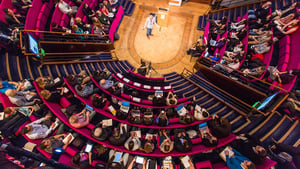
Royal Institution Christmas Lectures (1966)
The Royal Institution Christmas Lectures are a series of lectures on a single topic, which have been held at the Royal Institution in London each year since 1825. The lectures present scientific subjects to a general audience, including young people, in an informative and entertaining manner. Michael Faraday initiated the first Christmas Lecture series in 1825. This came at a time when organised education for young people was scarce. Faraday presented a total of nineteen series in all.
-

Episode 1 - Back from the Brink, the Science of Survival: Peak Performance
Release Date: 2007-12-24Dr Montgomery examines the theme of respiration. Just like racing car engines, humans use oxygen to burn fuels and release the energy that powers each function in every cell. So how do we get the oxygen from the air to the cell, and what happens when oxygen levels in the air are dramatically reduced? Dr Montgomery looks at the airways that carry the oxygen, and the rib-and-muscle bellows which drive air through them. He examines the lung and explains how it passes the oxygen on to the blood cells which grab and hold that oxygen. Then, viewers are shown how the heart pumps these cells around the body through a complex system of blood vessels, where the oxygen is passed onto the cells for another phase of processing. In the second half of the lecture, Dr Montgomery meets some mountaineers who have climbed Everest where there is three-times less oxygen than at sea level. What happens to these people’s bodies when they struggle to stand at the very top of the world?
-

Episode 2 - Back from the Brink, the Science of Survival: Completely Stuffed
Release Date: 2007-12-25Tonight’s lecture examines how food is processed and used by our cells. The food we eat contains the fuel we need to power our bodies. But what are these fuels? How do we get them from our dinner plates to our cells? And what other things are there in the food apart from fuel? Dr Montgomery explains what happens to the fuel and oxygen in a cell, describing how food is converted into an energy currency to be spent in different ways around the body. As well as focusing on normal function of the body, the lecture also explores how the body reacts to abnormal levels of food intake. What effect does gluttony have on the body? What happens when we are starved of food, or deprived of water? What happens when we become dehydrated? How long can someone survive without any fluids? And what happens if we miss some key bits of food out of our diet? Finally, Dr Montgomery turns his attention to people who have survived on the edge of existence as he meets some real-life castaways. How did their bodies cope without access to food or water for so long?
-

Episode 3 - Back from the Brink, the Science of Survival: Grilled and Chilled
Release Date: 2007-12-26How the body copes with extremes of temperature. Humans live in some extraordinary places –from the middle of the Sahara desert to the frozen wastelands of Alaska. Take a snake to the North Pole, and it will stop moving in minutes; take a cat to the desert and it will be dead in hours. So how can some humans survive such extremes, and could anyone? Dr Montgomery explains how our bodies burn fuel using oxygen to create an energy currency, which in turn creates heat. Viewers will discover whether shivering really works, whether a hot meal makes a difference to our internal body temperature and whether mothers are right when they say that you should wear a hat on a cold day. But what about when it is too hot? Where is the blood diverted in order to cool the body down? What is sweat and how does it work? And why do dogs pant, and humans not? Finally, Dr Montgomery meets some people who have survived in the very coldest places and the hottest places on Earth. What are the limits to human survival, and how close did these people come to death?
-

Episode 4 - Back from the Brink, the Science of Survival: Fight, Flight and Fright
Release Date: 2007-12-27The focus of tonight’s presentation is stress and exertion. When faced with a threat like the approach of a predator, a human’s natural response is to turn and flee. Yet a soldier facing enemy guns can choose to stand and fight. Such a decision and the subsequent physical work required involves burning a huge amount of energy. So how does the body deliver such a large amount of energy so rapidly? What happens to the heart, lungs and blood vessels used to transport the energy, and how is it used once it is delivered? In addressing some of these questions, Dr Montgomery takes a close look at the workings of the amazing, high-performance, all-terrain vehicle that is the human body. Viewers will learn what the skeleton is made of, how muscles move the skeleton, what these muscles are made of, how they create force, and how they are controlled by the computer in our skulls. With the help of some intrepid and athletic volunteers, Dr Montgomery explores if all muscles are the same and why it is that some people can sprint well, while others are adept at running for long distances. He then introduces somebody whose ability to keep going despite physical exhaustion saved his life.
-

Episode 5 - Back from the Brink, the Science of Survival: Luck, Genes and Stupidity
Release Date: 2007-12-28Tonight’s presentation examines the part genetics has to play in our ability to survive. Is everyone’s ability to survive the same? Faced with the same perils, would we all cope just as well? And if not, is it down to luck or relative toughness, or is there such a thing as the will to live? Dr Montgomery’s main focus tonight is the complex world of genes –what are they and how do they make us different. How much of the way we are is ‘nature’ and how much ‘nurture’? Do our genes influence our chances of survival? Can they protect us from infections, or help us survive them? Can they allow us to run further and faster? Can they even make us feel more or less pain? In the second half of his lecture, Dr Montgomery talks to some people who have survived in the face of adversity. To what degree do they credit their endurance to training and preparation, toughness, the will to live, genetics or just good, old-fashioned luck?
